#dissociative identity disorder book
Text
I just finished Chasing Dawn (The Alters) by Terra Katherine McKeown and aaaaaa!!!!
aaaaaaa!!!!! It so good!!!!
I don't have the time right now to write up the review, but if you want a thrilling urban fantasy with a really cool take on DID and magic, please check this out, it's so so cool!!! I am Hooked! I Am Compelled! In less pages than other certain books I've read, I'm so much more connected to each of the alters and their personal journies, as well as the magical lore.
If you check it out, please be mindful that there's some detailed fight scenes that get pretty bloody, implied sexual abuse and a chapter detailing ritual abuse(the chapter is titled Sigils and Scars Faded). I'll do a more detailed TW list when I can write my review
But yeah!!!! I loved this one
#did in books#did media#dissociative identity disorder book#dissociative identity disorder#media reccs#media recs#chasing dawn the alters#did in media#actuallydid#I am moving out very quickly and suddenly!! like literally just back from being with chimera we went wups no more house <3#im very very fortunate to even have a house to stay in#but ill be off to see R in two weeks anyway#so yeah sorry to get personal! i want to write a review but itll have to wait for a moments respite
23 notes
·
View notes
Text

“The body remembers everything the mind wants to forget.”
― Fiona McPhillips, When We Were Silent
#dark academia#classic literature#light academia#dark academia vibes#dark academia aesthetic#dark academia books#book quotes#books and reading#literature quotes#literary quotes#dissociative identity disorder#complex ptsd#childhood trauma#service dog#disability#poets on tumblr#writers and poets#dead poets society
141 notes
·
View notes
Text
You can't say "host" without "ho"
-our host
#taken from our quote book#did#did system#osdd system#osdd#dissociative identity disorder#system#did osdd#other specified dissociative disorder#system stuff#system things#osdd 1a#osdd 1b#highly complex dissociative identity disorder#highly complex did#complex dissociative identity disorder#cdid system#cdid#hc did system#hc did#actually median#median system#actually did#quotes#quote book#did memes#osdd memes#system memes
59 notes
·
View notes
Text

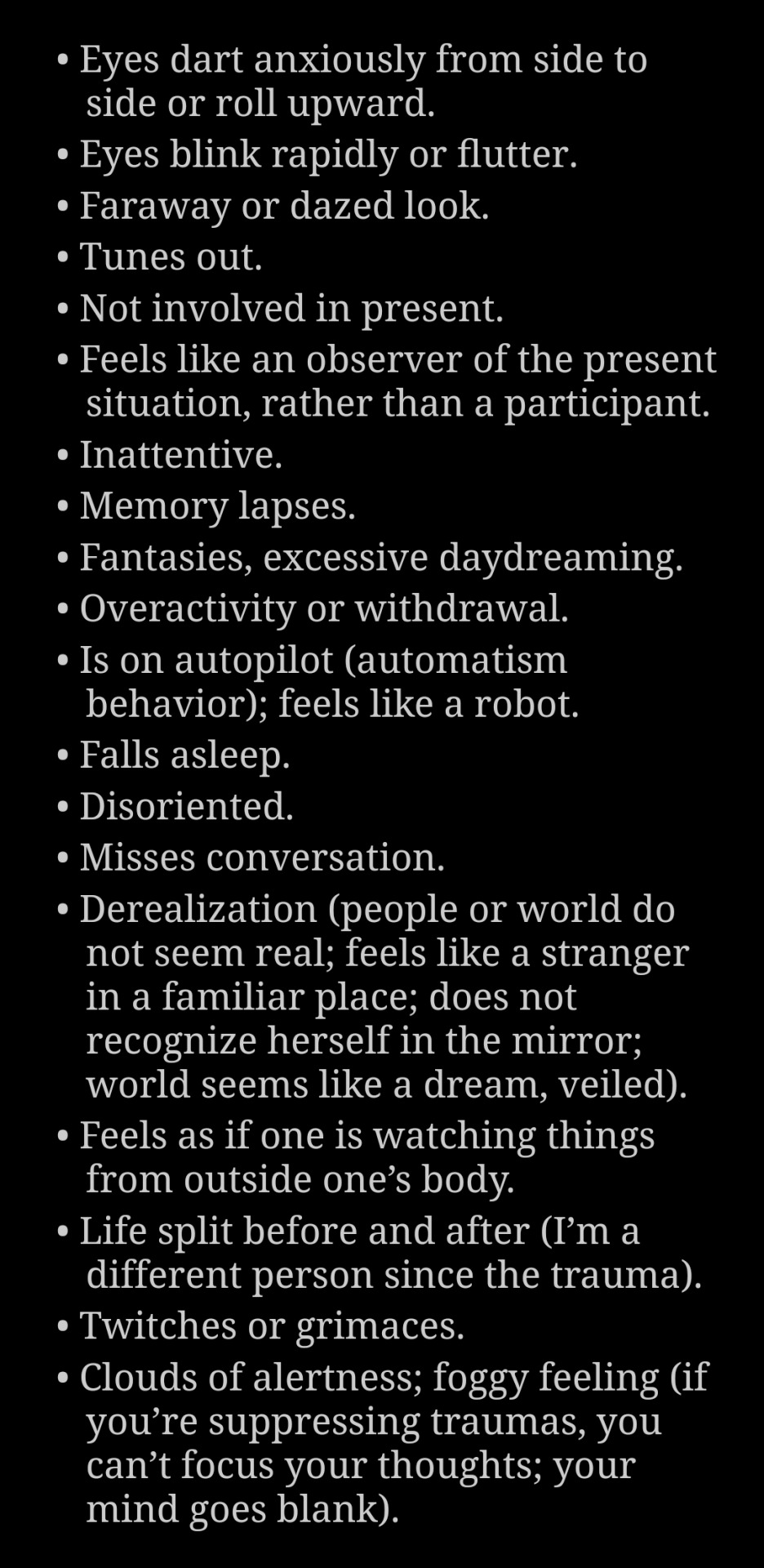

— The Dissociative Identity Disorder Sourcebook by Deborah Bray Haddock
[image ID: white text on black background
The habitual use of dissociation or switching as a defense is based not only on perceived threats, but also on an individual's perceived ability to cope. Consequently, as your stress level rises, due to present circumstances or triggers related to past trauma, the key issue becomes whether you believe that you have resources available that will allow you to cope. If, at some level, you do not believe you have adequate resources, or if you are triggered at a physiological level, you may begin to switch internal states. (See Figure 9.2.)
Body becomes still or stiff.
Person is slow to respond to others.
Things seem to move in slow motion or fast-forward.
Emotions become flat, numb; no feelings.
Not feeling expected pain.
Out of touch with surroundings.
Drifts off, goes away, spaces out (gets spacey), blanks out, loses track of what's happening.
Stares off into space, blank stare. Downward stare.
Eyes dart anxiously from side to side or roll upward.
Eyes blink rapidly or flutter.
Faraway or dazed look.
Tunes out.
Not involved in present.
Feels like an observer of the present situation, rather than a participant. Inattentive.
Memory lapses.
Fantasies, excessive daydreaming.
Overactivity or withdrawal.
Is on autopilot (automatism behavior); feels like a robot.
Falls asleep. Disoriented.
Misses conversation.
Derealization (people or world do not seem real; feels like a stranger in a familiar place; does not recognize herself in the mirror; world seems like a dream, veiled).
Feels as if one is watching things from outside one's body.
Life split before and after (I'm a different person since the trauma). Twitches or grimaces
Clouds of alertness; foggy feeling (if you're suppressing traumas, you can't focus your thoughts; your mind goes blank).
Unusual, inexplicable behavior (hits the ground when a car backfires; a dependable woman suddenly leaves the house for two days)
Attempts to remain grounded in the present (strokes side of chair, taps, jiggles leg).
Self-soothing (rocks back and forth).
Things look or sound different: colors are faded or brighter, tunnel vision, wide-angle view, sounds are louder or more muffled than expected, things seem far away or unclear and fogged.
Reprinted with permission from The Post- Traumatic Stress Disorder Sourcebook. Copyright 2000.
Figure 9.2 Possible Indications of Dissociation
/end ID]
325 notes
·
View notes
Text

here’s some interesting stuff about child parts within DID that i think not enough people hear or talk about. especially that part that says “child alters are not packets of childness retained in a surrounding area of adult psyche. they are stylized packets of adult psyche”. child parts are not real children, and have the ability to do and understand things that real life children will not.
[image ID: text from the book “understanding and treating dissociative identity disorder” by elizabeth howell. the text reads as follows:
CHILD PARTS
Most people with DID have at least several child parts. Child parts tend to hold most of the abuse memories. As a result, they are often exiled in the system (Schwartz, 1997) and avoided (Van der Hart et al., 2006) by other parts in the system, including the host, who do not want to be bothered with their painful feelings. Although it may seem odd to say this, one should keep in mind that child alters are not real children. Even while speaking in child- like ways, child alters often understand abstract concepts and long words. As Shusta-Hochberg (2004) noted: “It is important to remember that the patient is an adult, despite the childlike ego-states. These parts are not actual children” (p. 16). This is in agreement with Ross’s (1997) statement that “child alters are not packets of childness retained in a surrounding sea of adult psyche. They are stylized packets of adult psyche” (p. 147). The ages of child parts often correspond to ages at which they were abused, yet they may also be younger or older. Some may mature and become older in the treatment, as well as in life, and some may stay the same age.
end ID]
#-post#-info#syscourse#actuallymultiple#actuallydid#actuallytraumagenic#actuallydissociative#dissociative identity disorder#did#-books
367 notes
·
View notes
Text
Are everyone's alters super dramatic? Do they all put up a front and play a role that a child would think is intimidating, or funny, or comforting, or evil? Do they all want so much reactions from others, they're willing to overdo it at all times?
Is this happening because alters split in such young age, so the core of their behaviour is forged in a child's mind? Is that why there are so many introjects, characters from children's media that encapsulate concepts and emotions that would make perfect sense to a child? Does anyone's else's inner world look like a child created it? Almost unnecessarily over the top, but extremely expressive, filled with symbolism, atmosphere, subtle signs of what happened to them?
#alters#osdd#dissociative identity disorder#did#i can't find any books on did that are not filled with misinformation#so i have to find out this way
70 notes
·
View notes
Text

"“I can channel Arannan because he exists. Because he’s real! These people like Aberle that you claim you know— they’re not!”
Maybe Rowan was right. Maybe I never had enough reason to believe about half of my friends actually existed. Maybe I was delusional. The kind of liar that doesn’t even know they’re lying. Except… “But you told me you met Aberle in person. And slept with him.”
Your life is ruined, so you might as well write about it.
No telling if it'll be a cult classic or manifesto, but writing is all you're good at anyway. God knows you'd outlive the sun to get the last word in.
How did it end up like this? "The predictable story of how a hopeless romantic moved across the country just to be betrayed. Twice."? "The existential nightmare of how I found out the people I care about weren't real. Twice!" Then again, your attachment to reality was never a solid one, was it? Did it start with the faeries? Or maybe the one you dated that thought they were a vampire? (Which one?) "The tragic tale of how your dumbass dated someone who thought they were a vampire. Twice."
Tracing your steps back, you start to realise that you weren't the only victim of the Faerie Cult. "Bitter memoirs of how my 'friends' broke into my room and read my journals. Twice. No, three times. No, four. Five---" "Startling reports of how the supposed 'faerie' Actually Poisoned Someone. Twice." Oh, so you're not the only one with bad habits.
Maybe you have a chance to finally sort yourself out. Now that you know you have Dissociative Identity Disorder, now that you understand that these aren't 'ghosts' or 'interdimensional beings' or 'past-lives' you're channeling, but alters. And as it so happens, taking down an empire of manipulation is a group project. Say what you want about cults, but they do bring people together.
But what happened to the old host? Why did they disappear and leave you with this mess? And, more pressing, how do you stop the same thing from happening to you?"
#dissociative identity disorder#did system#living fiction system#cult#cult survivor#memoir#autobiography#rochester ny#savannah ga#xanthe zeitstuck#sparrow harvey#faerie fantasy house#buy my book
7 notes
·
View notes
Text
People like to gaslight those of us with Dissociative Identity Disorder by claiming that we have "False Memory Syndrome." The problem with that is that "False Memory Syndrome" doesn't actually exist and therefore isn't a diagnosis.
#writers on tumblr#writeblr#writing#creative writing#dissociative identity disorder#memoir#repressed memories#false memories#mental health#healing from trauma#books and reading#trauma
11 notes
·
View notes
Text
maybe a shot in the dark, but does anyone have recommendations for fiction books about Dissociative Identity Disorder?
I’m looking more specifically for actual clinical DID—so not “there are magical spirits taking host in my body in this fantasy world”—and of course nothing that deals with ‘murderer’ alters or Dr Jekyll & Mr. Hyde themes.
The pickings are SO slim that I don’t even mind if you didn’t like the book.
As of right now I’ve only found Pretty Girl-13.
#vanessa.txt#book recommendations#dissociative identity disorder#mental health books#mental health fiction#book recs#book rec asks
19 notes
·
View notes
Text
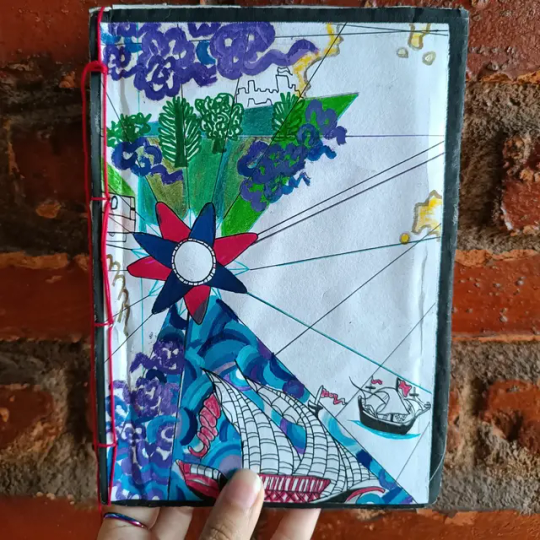



Artist Book, 2023.
About identity, gender and ancestry.
[ Collage, mixed media ]
#art#artist book#artist#contemporary art#collage#vent art#gender#dissociative identity disorder#ancestry#lgbtq artist#my art#artists on tumblr#collage art#aesthetic#mixed media
12 notes
·
View notes
Text
DID book Review

DID Book Review
Facts -
Book Title: Pieces of Me by Kate Mclaughlin
Publication date: 2023 (very recent!)
Fiction or Nonfiction: Fiction
Was there a diagnosis of DID? Yes! And very carefully done too
Was the person with DID presented as evil for having DID? Nope!
Major Trigger warning list:
- Mild sexual scenes/mentions of having sex
- Mentions of alcohol and vape usage
- A surprise suicide attempt (ch. 7-8) with descriptions of cutting and blood
- Lots of time spent in a hospital/psyche ward
- Loss of autonomy with lotsss of involvement with her family watching over her
- Non-descriptive incest
- Locking an alter away
Subjective Review(this is how I felt about it) -
Personal triggering scale from 1 to 10 (1 being not triggering at all, 10 being a badly overwhelming experience that might cause personal harm): 2 with the occasional 4-5(the surprise suicide attempt startled me)
Personal relatability scale from 1 to 10 (1 being unrelatable, 10 being OMG THAT’S ME!): 6
Personal avoidance scale from 1 to 10(1 being eager to get on with it, 10 being impossible to finish): 2, very easy!
My interpretation of the media(Includes spoilers):
The book opens with the main character waking up from a three-day long dissociative fugue state, beside a man she doesn’t quite recognize, but finds she can trust, beside her. Nothing dubious happened, there were no drugs or alcohol involved like she initially assumed (having a history with alcohol abuse and similar fugues). Our main character is sent into a spiral when her new friends address her as Lannie.. But her name’s Dylan.
We find out Dylan’s living a very idyllic life for the most part; her mother’s a semi-famous actress who’s able to give her two children a very comfortable life, including a nice house and letting them both study their respective arts. Dylan’s brother, Mark, is following in his mother’s footsteps into acting. Dylan finds herself to be the black sheep of the family in comparison, struggling with depression, anxiety and BPD all her life. There’s always something amiss with her that doctors haven’t yet figured out, particularly with the memory loss and dissociative tendencies. There’s obviously some tension in the family due to her having so many issues.
With this latest fugue state, it kicks off the search for an answer, any answer, as to why Dylan ends up in these situations. She finds art of hers in all different styles, and the characters she’s been drawing forever seemingly have a presence in her head. Her family and best friend become overbearing in the meanwhile, insisting she can’t be alone anymore, especially in the midst of her blooming romance with the mystery boy she woke up with, Connor. I appreciated that even in the book, Dylan finds it triggering to be so closely watched and loosing her autonomy, because personally that sounds like a nightmare.
After seeing some doctors in the search for something physically wrong with her, Dylan’s best friend suggests Dissociative Identity Disorder. Something she’d seen in youtube videos and did some further research into. She overloads Dylan with information, so she pulls away to process this all..
And wakes up again, this time evidently having attempted suicide in the bathtub.
That’s when the story cracks, and it’s taken from Dylan’s point of view to the other parts, as Dylan floats into the Inner world in a very vivid dream on the cusp of her attempt.
Her inner world is the same house she’d had some dreams of before, loaded with detail and personality that really makes the space her own, inside and out. She has a room of her own there, where she’s introduced to a host(ha) of new characters, like Lannie, Kaz, Dali, Alyss and Scratch. (Scratch being the one who evidently made the attempt on their life)
While in the hospital, Dylan goes through a carousel of parts, especially as her therapist works with her through taking the DES(Is that right? The diagnosis tests, all of em). Dylan is diagnosed with Dissociative Identity Disorder, and she launches herself straight into trying to understand herself with this fresh lens.
She goes quickly into trying to figure out what was The Trauma that did this to her, and everyone around her hedges around the same question. As she switches through her posse of alters, what’s left behind paints(or draws in this case) a pretty clear picture of childhood sexual abuse.. By who? No one knows. Everyone wants to know
After about two weeks or so in the hospital, Dylan comes home and gently eases into a life with DID very quickly, smoothly, easily. She builds relationships with her parts, especially Kaz and Lannie, who hang around often for daily life things. Her family, best friend and boyfriend all accept and love her as she is, even if they don’t always get it. But they try, especially the boyfriend, who studies up on helping his new girlfriend ground. (I thought that was very sweet, R does that for me)
It's decided though that Dylan needs to be monitored through her fugue states, and has very little privacy. This is shown.. As a good thing, now that she’s been diagnosed and all.. (I will expand on my thoughts here in a bit)
Halloween comes, it’s the twin’s birthday. Things are going very well, Dylan’s feeling very close to her system as they’d communicated more and switched out less. Life is on a high! She meets with her father and her little half sister and is able to rule out her father as any potential of having abused her…
And then the Uncle Travis shows up to the party. She just knows in her gut, all at once, that it was because of him.
In an instant, Dylan’s pulled back into the inner world to a movie theatre-like room, where all the Main Parts are gathered there. Monet, the part who greets them there, declares that it’s time to know Everything. So they sit down and watch all the memories together on the screen as a different part, Vincent, takes over the front. All together, they remember all the abuse that took place. (It’s described very vaguely, but there’s enough indication to understand that it’s grooming and repeated sexual abuse that took place with Uncle Travis)
Understandably, Dylan is overwhelmed and stays inside a few days. Lannie takes over. No one but the boyfriend had picked up that it was the uncle that did it yet, so the people around her are confused by the sudden change and kinda nudge for Dylan to come back out as soon as possible and adding pressure onto the “What Happened To You” thing again. With the therapists’ help, Lannie is able to switch back to Dylan and communicate to her mother that she can’t be pressured about telling her trauma.
At a family dinner out and about, Dylan is starting to pick up more and more of what makes her uncle a creep. With some concerning mentions of her little half sister spending time with him, she starts to panic when she sees he sits a little too close for comfort with the little sister, and as a hand touches her shoulder.. Dylan cracks.
Scratch comes out immediately, walks straight over and threatens Travis to keep his hands off and that she knows what he’d done. It’s enough to shake him off, the day is saved. the abuser is confronted.
When they get home from eating out, Dylan sits down her family(minus Travis) and explains that she now knows it’s Uncle Travis that had hurt her, and expresses concern for him to continuing the cycle of abuse with other girls, namely the little sister. Everyone is very accepting very quickly for her accusation of incest, but her father and brother stammer in shock to accept. This is snapped down on pretty quickly, though.
Dylan reports the uncle to the police very easily. Evidently everything is very cleanly taken care of because Uncle Travis is arrested shortly after. He attempts suicide in prison, and Dylan only feels the correct feelings feels no shame or apprehension, because he obviously only attempted it because he got caught.
Dylan has the perfect night with her boyfriend. With some warming up, they have the perfect sex.
Dali(the gatekeeper) and Scratch(Persecutor) relent their now obsolete roles and have a very nice, gentle fusion.
Everyone lives happily ever after in the land of functional multiplicity after a month and a half of being diagnosed!
~~~
This book is a Good book. By that I mean that it’s very very carefully written to be respectful and cleaned up to have the right representation. The kind of book you pat on the head and say “Good book!” like a pet who’s successfully fetched the morning paper. It’s written to be very appropriate without any explicit details especially with the trauma memories, to be good for teens to read. I’m absolutely certain that YA DID books are a good niche for this to fill.
But it’s.. Very.. Very clean for a DID representation.
I think all the details for the diagnosis process and healing are correctly written.. For a character who has all the privileges in the world handed to her. A good, honest family who genuinely loves her. Financial support enough that no medical assistance is barred off from her. A good boyfriend who immediately understands. Communication that goes really fucking well right off the bat, the ability to traverse the inner world very quickly.
An immediate understanding of who did it to her. Confrontation of her abuser and his very squeaky clean arrest. All the Correct Feelings. There’s no fighting back from a family confronting the reality of incestuous abuse. There’s no questioning her own memories or real denial portrayed with Dylan aside from a couple of tiny instances sprinkled in.
This is a good book, I’m sure!! But when I read it, I came away feeling.. like I was the dirty one, someone who wasn’t doing it ‘right’, because my healing is incredibly messy and I don’t have an ounce of support from my family like that. I have all the incorrect, messy feelings that lead me to me wanting my own sexual abuser to confirm that I’m lying and that I’m actually the one who hurt him, and have this massive terror of him facing consequences or being hurt.
I’m certain that a lot of the limitations to depth were due to a word count and a genre limitation, as well as the author’s inexperience with dissociation.
There’s a lot of leaning into some tropes that leave a slightly bitter taste in my mouth, like the insistence that Dylan is the Host and therefore Most Important Of Them All. The family having such a hands-on approach with how she heals makes my skin crawl(as I’m sure many others would feel, because a majority of childhood trauma survivors come from abusive, controlling families), as if Dylan is no longer trustworthy of her own safety because of her new diagnosis. The slap-on-the-persecutor’s-wrist-for-doing-their-job thing.
(By the way, I want to add that anyone who needs extra support for having a CDD is completely valid!! I do too! But having the family partake in this just.. aaaaa it feels very scary to me!! Especially since Dylan’s persecutor part is an introject of her own mother, and that’s.. Really not touched upon much at all)
The book is Correct. But it’s also.. I don’t know, it leaves me wondering who it’s written for, with such a sanitized version of DID shown here. I’m sure lots might actually find this book empowering, especially if you relate more to Dylan. It’s also a very very easy read because the triggers are kept thankfully super minimal. Maybe this is the book for you? It might be good for you, or it might be alienating, only you can be the judge of that. It feels more like a curiosity for those without a CDD to read(like the author herself)
What they got Right in my opinion:
- The research and terms used to describe trauma and dissociation seem all up to date
- Dylan gets a formal, proper diagnosis with both her therapist anddd a phycologist. (It sounds accurate based on what I’ve heard)
- Each of the Parts that part-take(hehe) in the book seem fleshed out and very well thought-through. They feel like very believable and real parts with believable attachments to each-other. The writer did really nice on building the relationships
- I really liked the grounding exercises they used in the book! (I tried the one of thinking of animals for the first 5 letters of the alphabet, it really worked?) The boyfriend using multiple senses to calm her down from overstimulation was really nice(a lottt like what R does,..ahh I miss him so)
- I liked that Dylan was an artist and had actually been drawing Lannie all her life.
- Scratch being an introject of her mother and having references to the movie Coraline actually line up pretty well with the age Scratch probably split off from, so I found that a bit sneat
- I liked that Scratch was the one to call out her abuser to protect her little sister, because Scratch was made of resentment for her mother’s not protecting her.
- Subtle clues throughout that Dylan has trauma before the diagnosis(aversion to touch, inability to connect to people, past alcohol abuse)
What they got Wrong in my opinion:
- The extreme ease to which Dylan accesses the inner world, starts communicating and figuring out her memories within… 2 weeks…?
- Hardly an ounce of denial, either from Dylan, or any of the characters around her. A lot of people aren’t open to understanding DID like that, or even accepting it as a reason for why the way you are.
- I almost feel like it’s dangerous to insinuate that you should trust your family with so many details about your disorder. (Driven by DID youtube, I told my mom everything once and I’ve regretted it horribly since. This is a memory disorder!! BE CAREFUL OF WHO YOU TELL!! People take advantage of that!!!!!!)
- Again, in the case of incest in the family, I highly highly doubt telling the family about it ever goes this smoothly. Especially since this is for teens, who likely still have to live with their families, I worry about the influence of ‘must trust your family with details’ might have (again speaking from experience :’) ) I really would have preferred if Dylan’s safety was a found family thing instead
- The reporting it to the police and having everything solved extremely easily is just.. Insulting to anyone who’s actually had to go through that. Especially for those of who never could find the safe resolve they deserve :(
- Blackout switches nearly every switch
- The many mentions of locking away and punishing Scratch for attempting suicide was really difficult to read.. Especially when this was shown as a net positive
- Host Is Most Important Part trope
- Host is the only one who Doesn’t Know Yet trope
- Everything happening in like 2 months???? Extremely easy healing
- No conflicting worries or feelings about Travis, just all the Right emotions pretty much right away(hatred, desire for justice, ect)
- A weird line of thinking about how Dylan Created this, as if she had any choice in splitting.
Would I recommend this to someone with DID to read?: It’s up to you. In some cases, positive reps with happy endings might be just what you need, so I say go for it! But in other cases, it might fuel denial or feelings of self hatred for not being ‘easy’ like this.
If you choose to read, please keep these two things in your pocket: This story is about someone who’s incredibly privileged, and You are not Broken for not healing in 2 MONTHS
#pieces of me#Kate McLaughlin#dissociative identity disorder#complex dissociative disorder#DID in media#actuallydid#dissociative identity disorder fiction#dissociative identity disorder book#did book#bunnidid reviews
37 notes
·
View notes
Text

“I love New York, even though it isn't mine, the way something has to be, a tree or a street or a house, something, anyway, that belongs to me because I belong to it.”
― Truman Capote
#dark academia#dark academia aesthetic#dark academia vibes#classic academia#light academia#disability#classic literature#books and reading#service dog#dissociative identity disorder#complex ptsd#truman capote#dark academia moodboard#dark academia fashion#dark academia quotes#chaotic academia#new york#new york city#nyc#writers and poets#dead poets society#poetsandwriters#poets on tumblr
102 notes
·
View notes
Text
I got Sybil from the library to read. I know that books been a bit controversial, does anyone know much about it? Am curious. I don’t think I’ve heard from anyone with DID talk about it much
#sybil#bunny reads library books saga#not bunny tho not anyone#u can reply or send asks if youd like#dissociative identity disorder#i need to make that list of did books already because theres literally just sybil#theres a few on trauma in general tho so i might look at them too someday
17 notes
·
View notes
Text
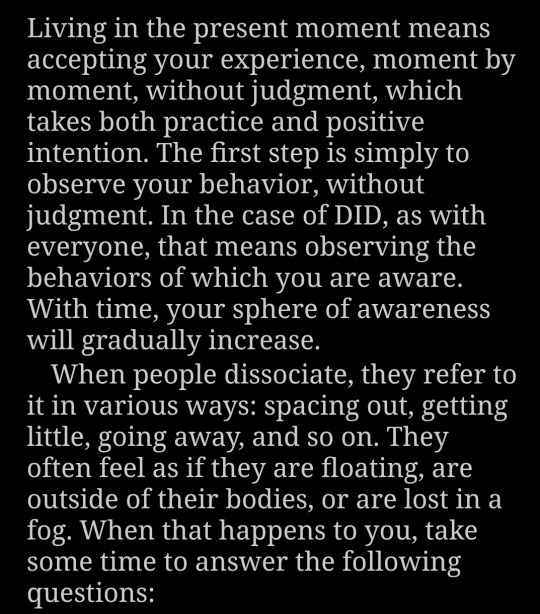

— The Dissociative Identity Disorder Sourcebook by Deborah Bray Haddock
[image ID: Living in the present moment means accepting your experience, moment by moment, without judgment, which takes both practice and positive intention. The first step is simply to observe your behavior, without judgment. In the case of DID, as with everyone, that means observing the behaviors of which you are aware. With time, your sphere of awareness will gradually increase.
When people dissociate, they refer to it in various ways: spacing out, getting little, going away, and so on. They often feel as if they are floating, are outside of their bodies, or are lost in a fog. When that happens to you, take some time to answer the following questions:
1. What happened right before I started to dissociate?
2. What was I feeling, both physically and emotionally?
3. What is the last thing I remember?
4. I knew that I was dissociating because
a. I started (tapping my foot, feeling dizzy, getting a headache, etc.);
b. I stopped (talking, thinking clearly, making eye contact, etc.);
c. I started to think (I'm going to die, people can't be trusted, I never do anything right, etc.).
5. What was I trying to avoid?
6. What else could I have done?
Initially, you may find you need help in answering some of these questions, but with practice, you will begin to identify the patterns associated with why and how your dissociation operates.
Figure 9.3 Practice Sheet for Staying in the Present Moment
/end id]
54 notes
·
View notes
Text
Thank you SO much for these incredible pictures Sarah Rayburn and 11:11 Photography by Sarah. I love how they turned out!!
The first picture is what I’m currently planning to be the cover of my new poetry book The open vault.
I wanted the pose to represent the magician’s pose in the tarot honoring the hermetic principle of correspondence (as above so below) and I wanted to pose topless showing my bare back to represent the vulnerability that I’m expressing in my book. I’m so excited for this book to be finished and available for sale!
I’m still working on recording all 120+ poems of my book for the audio book and have been trying to enjoy the process and not burn myself out. I just finished chapter 34 the other day so I’m steadily making my way through.
This is so exciting! ✨
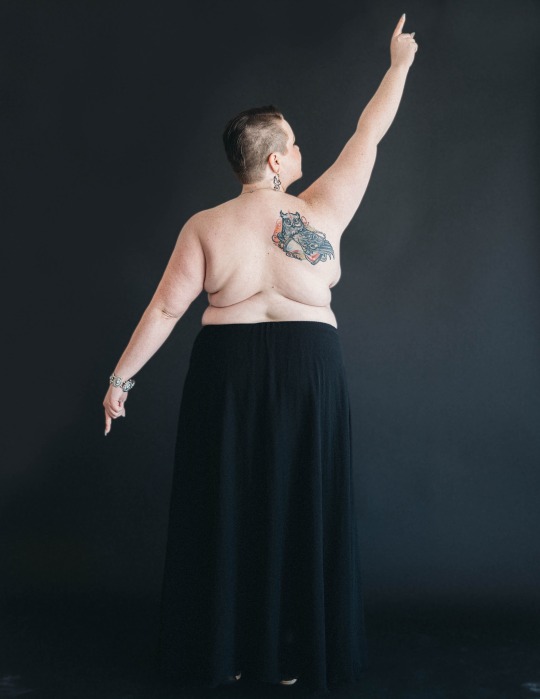



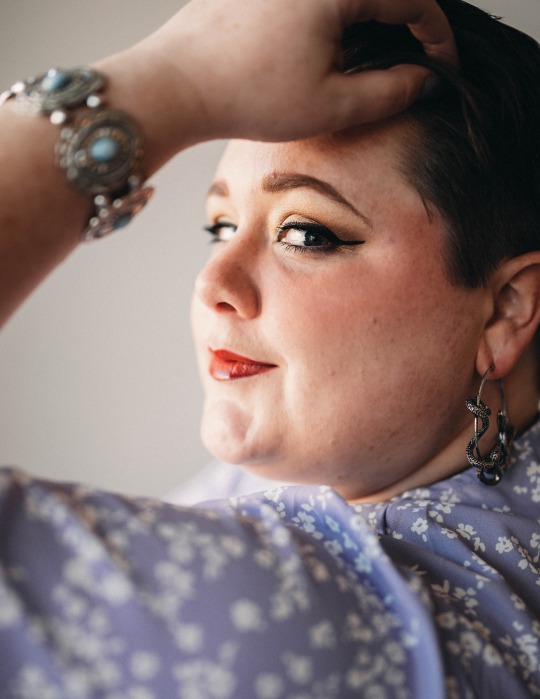



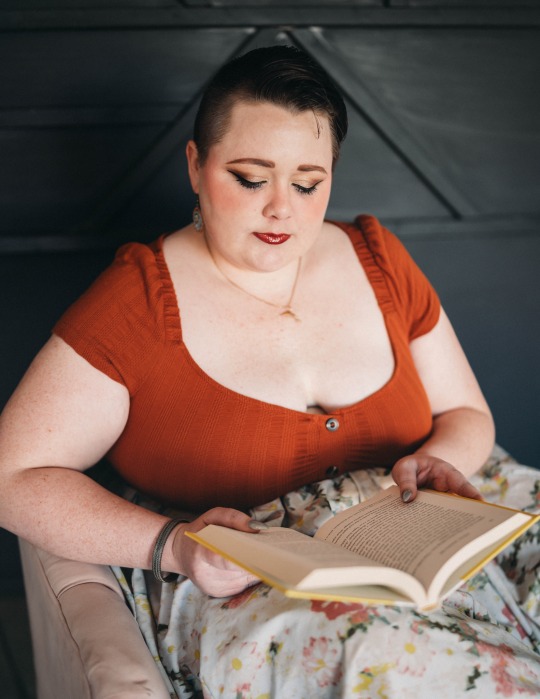

#art#photography#photo shoot#The open vault#original book of poetry#poetry#anticapitalistic#anticapitalist#anticapitalism#anti capitalism#disabled#disabled veteran#actually disabled#did#actually dissociative identity disorder#dissociative system#actually cptsd#actually dissociative#cptsd#cptsd survivor
6 notes
·
View notes
Text
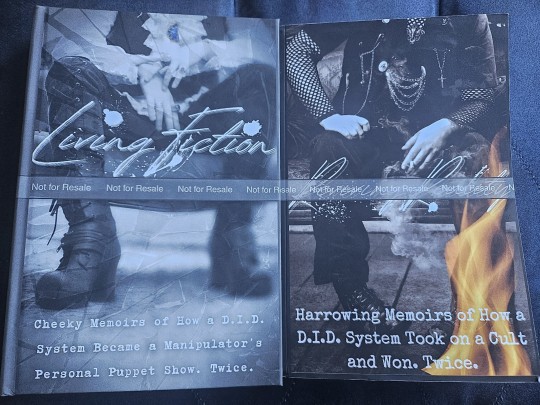
Received the proof, corrected some formatting errors, now it's in the process of publishing.
Seeing them side by side gives me chills.~
-Xanthe 🪶
5 notes
·
View notes